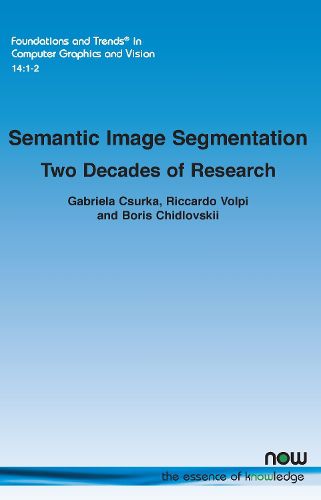Readings Newsletter
Become a Readings Member to make your shopping experience even easier.
Sign in or sign up for free!
You’re not far away from qualifying for FREE standard shipping within Australia
You’ve qualified for FREE standard shipping within Australia
The cart is loading…






This title is printed to order. This book may have been self-published. If so, we cannot guarantee the quality of the content. In the main most books will have gone through the editing process however some may not. We therefore suggest that you be aware of this before ordering this book. If in doubt check either the author or publisher’s details as we are unable to accept any returns unless they are faulty. Please contact us if you have any questions.
Semantic image segmentation (SiS) plays a fundamental role towards a general understanding of the image content and context, in a broad variety of computer vision applications, thus providing key information for the global understanding of an image.
This monograph summarizes two decades of research in the field of SiS, where a literature review of solutions starting from early historical methods is proposed, followed by an overview of more recent deep learning methods, including the latest trend of using transformers.
The publication is complemented by presenting particular cases of the weak supervision and side machine learning techniques that can be used to improve the semantic segmentation, such as curriculum, incremental or self-supervised learning. State-of-the-art SiS models rely on a large amount of annotated samples, which are more expensive to obtain than labels for tasks such as image classification. Since unlabeled data is significantly cheaper to obtain, it is not surprising that Unsupervised Domain Adaptation (UDA) reached a broad success within the semantic segmentation community. Therefore, a second core contribution of this monograph is to summarize five years of a rapidly growing field, Domain Adaptation for Semantic Image Segmentation (DASiS), which embraces the importance of semantic segmentation itself and a critical need of adapting segmentation models to new environments. In addition to providing a comprehensive survey on DASiS techniques, newer trends such as multi-domain learning, domain generalization, domain incremental learning, test-time adaptation and source-free domain adaptation are also presented. The publication concludes by describing datasets and benchmarks most widely used in SiS and DASiS and briefly discusses related tasks such as instance and panoptic image segmentation, as well as applications such as medical image segmentation.
This monograph should provide researchers across academia and industry with a comprehensive reference guide, and will help them in fostering new research directions in the field.
$9.00 standard shipping within Australia
FREE standard shipping within Australia for orders over $100.00
Express & International shipping calculated at checkout
This title is printed to order. This book may have been self-published. If so, we cannot guarantee the quality of the content. In the main most books will have gone through the editing process however some may not. We therefore suggest that you be aware of this before ordering this book. If in doubt check either the author or publisher’s details as we are unable to accept any returns unless they are faulty. Please contact us if you have any questions.
Semantic image segmentation (SiS) plays a fundamental role towards a general understanding of the image content and context, in a broad variety of computer vision applications, thus providing key information for the global understanding of an image.
This monograph summarizes two decades of research in the field of SiS, where a literature review of solutions starting from early historical methods is proposed, followed by an overview of more recent deep learning methods, including the latest trend of using transformers.
The publication is complemented by presenting particular cases of the weak supervision and side machine learning techniques that can be used to improve the semantic segmentation, such as curriculum, incremental or self-supervised learning. State-of-the-art SiS models rely on a large amount of annotated samples, which are more expensive to obtain than labels for tasks such as image classification. Since unlabeled data is significantly cheaper to obtain, it is not surprising that Unsupervised Domain Adaptation (UDA) reached a broad success within the semantic segmentation community. Therefore, a second core contribution of this monograph is to summarize five years of a rapidly growing field, Domain Adaptation for Semantic Image Segmentation (DASiS), which embraces the importance of semantic segmentation itself and a critical need of adapting segmentation models to new environments. In addition to providing a comprehensive survey on DASiS techniques, newer trends such as multi-domain learning, domain generalization, domain incremental learning, test-time adaptation and source-free domain adaptation are also presented. The publication concludes by describing datasets and benchmarks most widely used in SiS and DASiS and briefly discusses related tasks such as instance and panoptic image segmentation, as well as applications such as medical image segmentation.
This monograph should provide researchers across academia and industry with a comprehensive reference guide, and will help them in fostering new research directions in the field.